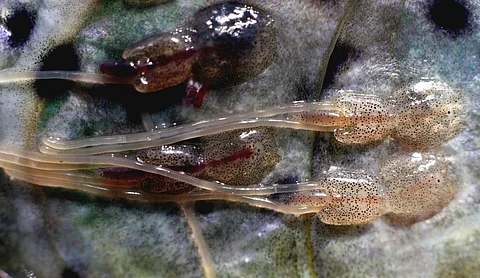

A close-up of sea lice parasites attached to fish skin. "The production of salmon lice has never been higher in the north than it is now," says marine scientist Anne Sandvik.
Photo: Havforskningsinstituttet.
Northern Norway is experiencing an unprecedented surge in sea lice populations, with marine scientists reporting record numbers of the parasites. The outbreak, linked to unusually warm sea temperatures, poses a significant threat to both farmed and wild fish stocks.
Marine scientist Anne Sandvik, who monitors lice levels weekly, warns that the production of sea lice has never been higher. "In the north, we saw an explosive increase and a multiplication of lice larvae numbers this summer," she said in a news release by Norway's Institute of Marine Research, based on data collected from Norwegian fish farms.
The spike occurred between weeks 30 and 34 (from July 22 to August 25), as temperatures rose well above seasonal norms. A recent report shows that sea temperatures in parts of northern Norway reached as high as 16.85°C in August, several degrees above the usual 12–13°C recorded in areas like the Lofoten archipelago in the Arctic Circle.
The timing of the lice outbreak is particularly concerning for wild fish species such as sea trout and Arctic char, which are vulnerable to infestation as they linger in coastal waters longer than salmon.
"The risk that sea trout will be infected with harmful amounts of lice has increased in recent weeks," Sandvik explains. Sea trout, which stay further out in the fjords than Arctic char, are especially at risk, she says.
Salmon lice feed on the skin of fish, and in severe cases, can cause significant damage or even death. In some areas, the number of adult female lice on farmed fish has doubled compared to last year.
According to the Norwegian Marine Research Institute, in week 30 (22-28 July 2024), farms in Production Area 8, a key aquaculture producing zone in central Norway, primarily covering the Trøndelag region, reported twice as many adult female lice this year as in 2023.
"The red line shows how the production of sea lice larvae has increased in recent weeks compared to the last three years. In the same period, the sea temperature has also been higher than normal. The figure shows the situation in Production Area 12, which is Western Finnmark in week 34, but other areas also have a lot of lice," says the Norwegian Marine Research Institute.
Image: Havforskningsinstituttet.
The dramatic rise in lice populations is closely tied to elevated sea temperatures. Sea lice have faster life cycles in warmer waters, allowing them to mature and reproduce more quickly, while higher temperatures also enhance their ability to attach to fish, leading to larger outbreaks, Sandvik explains.
"At a depth of 3 metres, where fish farms often measure temperatures, readings have been 3-4 degrees higher than usual in northern waters, providing optimal conditions for lice," says Sandvik.
Fish farms are one of the primary breeding grounds of sea lice, which can also spread to wild fish. A single fish farm can produce millions of lice larvae, especially when sea temperatures favour rapid reproduction, Sandvik explains.
"If we assume that a single cage contains between 100,000 and 200,000 fish, and each of these has 0.5 adult female lice (which is the legal limit from week 27 in the north), this cage would have 50,000 to 100,000 adult female lice before the fish must be deloused," explains Sandvik.
And, with fish farms in northern Norway reporting a quadrupling of adult female lice in some areas, the situation has reached alarming levels.
Between 19-25 August (week 34), 56 out of 558 fish farms along the Norwegian coast exceeded the legal limit for lice infestations. The Institute of Marine Research says it is continuing to monitor the situation closely, using both farm reports and independent temperature readings from sources like Barentswatch.
Map from 15 August showing a marine heatwave in the northern coast of Norway, measured in °C.
Image: Havforskningsinstituttet.
While lice numbers remain high in southern Norway, the situation has not worsened compared to previous years, as temperatures in the region have been closer to normal, the Institute says.
However, as northern waters continue to warm, marine researchers and fish farmers face an escalating challenge in managing lice outbreaks.
The full impact on wild fish stocks in northern zones will be assessed in the coming months, with full results from the Institute of Marine Research's monitoring program on wild salmonids (salmon, sea trout, and Arctic char) expected later this autumn.
The status of sea lice levels in Norway's different aquaculture production areas is updated weekly on the Marine Research Institute website.
